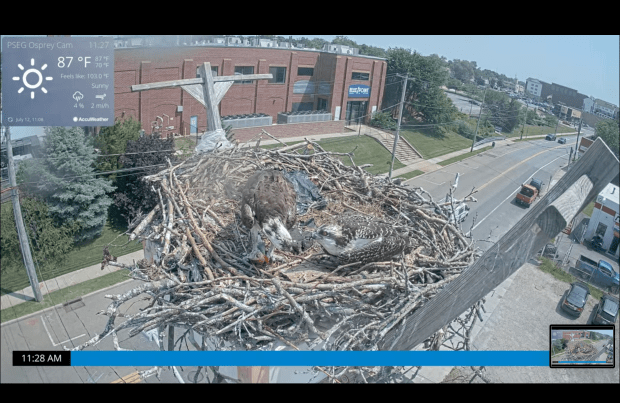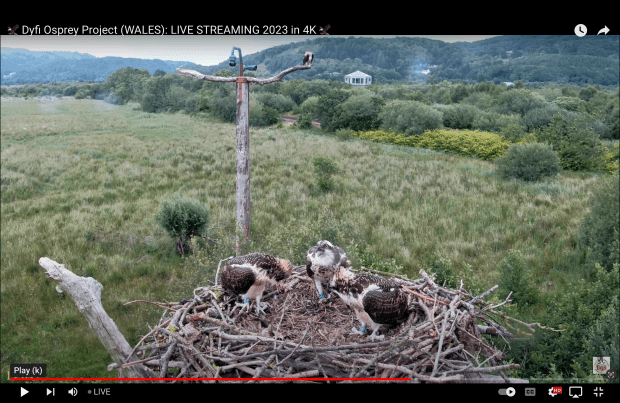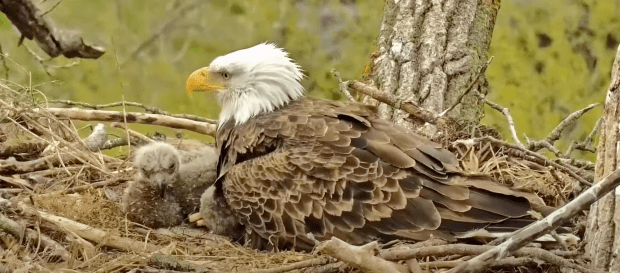15 March 2024
Good Morning Everyone,
Spring is coming and with it the arrival of Canada Geese, songbirds, and Ospreys amongst other raptors.

Today, more than a thousand Canada Geese turned the sky black at Fort Whyte Alive in Winnipeg. Most landed on the Bison fields while a few went to the open water on Devonian Lake and others decided to peck at the ice inside the nature centre.




As the Ospreys arrive at their nests around the world, laying eggs, and hatching osplets, I begin to be a ‘little more scattered’ than I might normally be. Last year, the total number of eggs that ‘H’ and I observed was 338. This year we hope to bring that total to 500. It is an enormous task. I am extremely grateful to those who have reached out to me, offering to send me information on the nests that they are watching. So, as a reminder, if you watch a particular osprey nest, please feel free to send me the date the eggs were laid and the dates of the hatch, and please do tell me if you are observing the chicks bashing the daylights out of one another. This could be ‘dominance play’, or it could be serious and result in siblicide. Even if you miss all of the major events but tune in to a nest and notice aggressive behaviour or something worrisome, do let me know. I appreciate any and all messages!
Let us go back to Dr Alan Poole’s talk. In my last blog, I talked about his first main topic—issues related to fish and the problems that the Ospreys face with the Chinese fishing trawlers taking huge nets of surface fish such as Manhadan and Mullet along the Atlantic and Gulf coasts of the US and West Africa. The other three topics were Problem Nests, Restoring Osprey Populations, and Streaming cams.
Problem Nests: Dr Poole pointed out that not having enough nests for ospreys is a ‘positive’ problem when you have too many ospreys. He notes that Greece has not a single osprey. Poland is shooting all of theirs, the Balkans have none, etc. There are 8-10,000 Osprey pairs in the Chesapeake Bay Area of the US alone. Imagine. There are 5000 nesting pairs in Florida. So, what do they use? Ospreys have adapted to use human-made structures because there are not enough good trees. In fact, this is becoming a serious problem for Bald Eagles. One human-made structure that Ospreys use are the hydro or power poles. The power companies don’t like this. They try to kick them off. It is, in fact, easy for the power companies to add an auxiliary appendage or put up an additional pole for the birds. But it takes time, employees, and money – something the companies either don’t have or don’t want to use. So when you see a power company that actually helps the ospreys, thank them! Poole is trying to find ways to get the power companies on board. In Florida, a lot of ospreys are using cell towers. So far, there has not been a problem. Of those 8-10,000 pairs in the Chesapeake Bay region, 20-30% use channel markers. The Coast Guard needs an award, according to Poole, because they allow the birds to have their nests there as long as they do not interfere with the markers. Some people put up very short poles with predator guards in salt marshes. It was pointed out that salt marshes might be a good place to try and locate some of the birds. In Finland, there are very few suitable trees for the ospreys, so the Finns cut off the top of the conifer trees and put up human-made platforms for them. It is brilliant. This could be done for the eagles and ospreys in various parts of North America, too. In the UK, we know that artificial platforms are being built, which is also happening in France.
Restoring Osprey Populations: Poole calls Ospreys “the stay-at-home birds”. Most of the time they stay within a region around the nest where they fledged. We know that this is especially true for the males. But this behaviour causes issues with overpopulation, especially where there is a lack of fish, bad storms, etc. So what do you do? You try to relocate some of the population to places without food and birds. The Roy Dennis Wildlife Foundation is well known in England for translocating ospreys to places like Italy, Spain, and the UK. Poole mentioned that Massachusetts ospreys are now being flown to Illinois to try and get them to populate along the Mississippi Flyway. If you move ospreys where you want them, you must provide them with nesting platforms. This is imperative. Switzerland is currently trying to reintroduce the raptors. They have released 50 young in the last five years. Starting a breeding population in a new area takes at least a decade.
There was a slight move off topic before looking at streaming cams but it was an important one – one of the most important in my mind. That is getting people knowledgeable about the history, the persecution of ospreys, their behaviour, what makes me different from other birds, etc. Poole noted that various places have set up visitor centres where people can watch the ospreys on a monitor or at hides. One is Loch Garten in Scotland, which had 2 million visitors look at their birds. These visitors paid to see the raptors. In Finland, the visitor centre, which is quite small compared to Loch Garten, had enough visitors that it paid for all of the Osprey research. One way to create awareness is through education. Tim Mackrill was not mentioned, but he has set up the Osprey Leadership Foundation and, like Sacha Dench and The Flight of the Osprey, they have forged links between individuals in the UK and West Africa. It is fundamental to have the youngsters in both countries (their parents and teachers) appreciate the birds they share. Poole also noted that some places have fairs and events and there are osprey mascots to encourage interest.
The last topic was streaming cams, and I felt that while quite knowledgeable, Poole knew less about the current number of streaming cams and the amount of research that is going on using them. Perhaps I am wrong. He suggested that one way to understand the ‘fish problem’ was to monitor the fish species brought to a nest, the number, how those fish were divided up in terms of feeding the little ospreys, etc. ——– I sighed because I knew that so many of you have counted the fish, the bites, have cried, pulled your hair out, etc at many of the nests including Achieva and Patchogue – just two examples from 2023. Citizen scientists are doing it every day. Your work – meaning each of you -needs to find a way to channel itself to the researchers who need more time, the funds, or the staff to monitor enough nests. I know this from personal experience. Various other species have individuals watching, and we now have observation boards set up at several Osprey cam sites thanks to Bart Molenaar. I can think of three he has established – Rutland Manton Bay, Seaside, and Port Lincoln. Every aspect of the life of the nest was recorded through observations and the chat. It’s a really valuable archive.
At Loch of the Lowes, Blue NC0 is eating well and working on her nest. She awaits the arrival of Laddie, her mate (LM12).

At Achieva Credit Union’s osprey platform in St Petersburg, Florida, Jack brought in a nice fish and Diane gently fed the wee babe often. Jack was also kept busy being security guard for the nest.
Dad was so excited. ‘MP’ observed Dad listening and walking around Diane. Part of the shell was out from under Mum, but the little one was still partially in the shell, with Mum being very secretive. You could tell Dad was quite happy to have a wee babe in that nest.


Mary Kerr put in some interesting notes about Maya and Blue 33 on FB today. As you know, Maya arrived a couple of days ago with Blue 33 returning Wednesday on Rutland’s Manton Bay platform. On Thursday, Blue 25 came to the nest and Maya sent her packing.

Blue 25 does cause some mischief. However, Geemeff reminds me that she is the mother of Blue 4K, the subject of Simon Curtis’s book, If you build it, he will come, the story of waiting 200 years to have ospreys at Belvoir.

First Osprey sighting at Forsythe! Thanks, ‘H’,

Was there an Osprey at Patchogue? There was!!!!!!!! They have a lot of work to do but thankfully much of the harmful debris is ‘under’ the nest.

It is extremely difficult to watch the West End nest of Thunder and Akecheta today because he wind was really whipping it about. The majority of the time I could only see two heads getting fed. That said right after 1106 you can see the blur of the third and it appears to have eaten.
That 1106 feeding.

Others.


There is plenty of food and Thunder and Akecheta are experienced adults.

Dixie and Mason are scooting all over the Superbeaks nest. It won’t be long til they are walking on those big clown feet.


The kids at Johnson City are both eating well. Boone has lots of fish in the nest and Jolene is a great Mum to these two.


Leaper and Jersey both had crops at Duke Farms today. At one point, Leaper was so full she looked like she would burst!


Swampy and Blaze are huge compared to these bobbleheads.


At Captiva, Cal flew off the nest on Wednesday. He flew around the area constantly observed by Clive and Connie. Today, he flew back to his natal nest. Well done, Cal!
Nothing like a lot of flying to make you want to go home to your bed and sleep duckling style.



Ron brought R6 a fish in the early afternoon. So cute. R6 had been working his wings Thursday morning. Not ready for fledge yet and still working on the self-feeding. No hurry, R6.

A lot of people thought E23 had fledged but he was up above the camera on Thursday. He could fly anytime!


Caught Gabby at the NE Florida nest today. She’s a beauty. We adore her and I am so glad that her and Beau are so bonded. Next year!

Chase and Cholyn’s only egg at Two Harbours was laid on February 22nd, making itay. In a fortnight, we should be expecting a pip/hatch on March 28th. 22 days old todMark your calendars.


Liberty and Guardian had three eggs. One was broken in the nest and it is unknown which of the three was lost. Those eggs were laid on Feb 15, 18, and 21. That would make them: Egg #1, 29 days, #2 26 days, and #3 would be 23 days old. We have at least a week to find out if egg #1 is alright.


It is now officially confirmed that Frederick and Betsy are back at the Carova Beach, North Carolina Outerbanks Osprey platform. — Don’t get me started. Look at those plastic carrier bags on the nest and around the foot of one of the adults!



I thought Annie might be ready to lay her first egg today. She was napping in the scrape when Archie, Daddy Door-Dash, came in with dinner.
There are currently three Peregrine Falcon eggs at the scrape in Eden, Netherlands. The third was laid on the 13th of March.


Waiting for Duke and Daisy to return to Barnegat Light in New Jersey. The couple lost 2 out of 3 chicks to starvation/siblicide during the Nor’easter of June 2023 and it was feared, for some time, that Duke might have died also. His return some weeks later was such a great relief for everyone.

Lucy was on the Lake Murray platform on Thursday.

Did Spirit visit her natal nest at Big Bear on Thursday? Cali Condor thinks it could have been her.
I am so looking forward to the Cornell RTH season. Big Red and Arthur were both checking and tweaking the nest and spending time on the light stand. Eggs could come any time.



Thank you so much for being with me today. Remember to go outside and smell spring! It will lift your spirits more than you ever will know. Take care. See you soon!
Thank you to the following for their notes, posts, presentations, and streaming cams that helped me to write my post today: ‘H, J, MP’, Alan Poole, Scottish Wildlife Trust (LOTL), Achieva Credit Union, Mary Kerr, LRWT, Forsythe Osprey Cam, PSEG, IWS/Explore.org, Superbeaks, Johnson City-ETSU, Duke Farms, Eagle Country, Window to Wildlife, WRDC, SW Florida Eagle Cam, NEFL-AEF, FORE, Carova Beach Osprey Cam, SK Hideaways, EDE Peregrine Falcon Cam, Lake Murray Ospreys, and Cali Condor.






























































































































































































































































































































































































